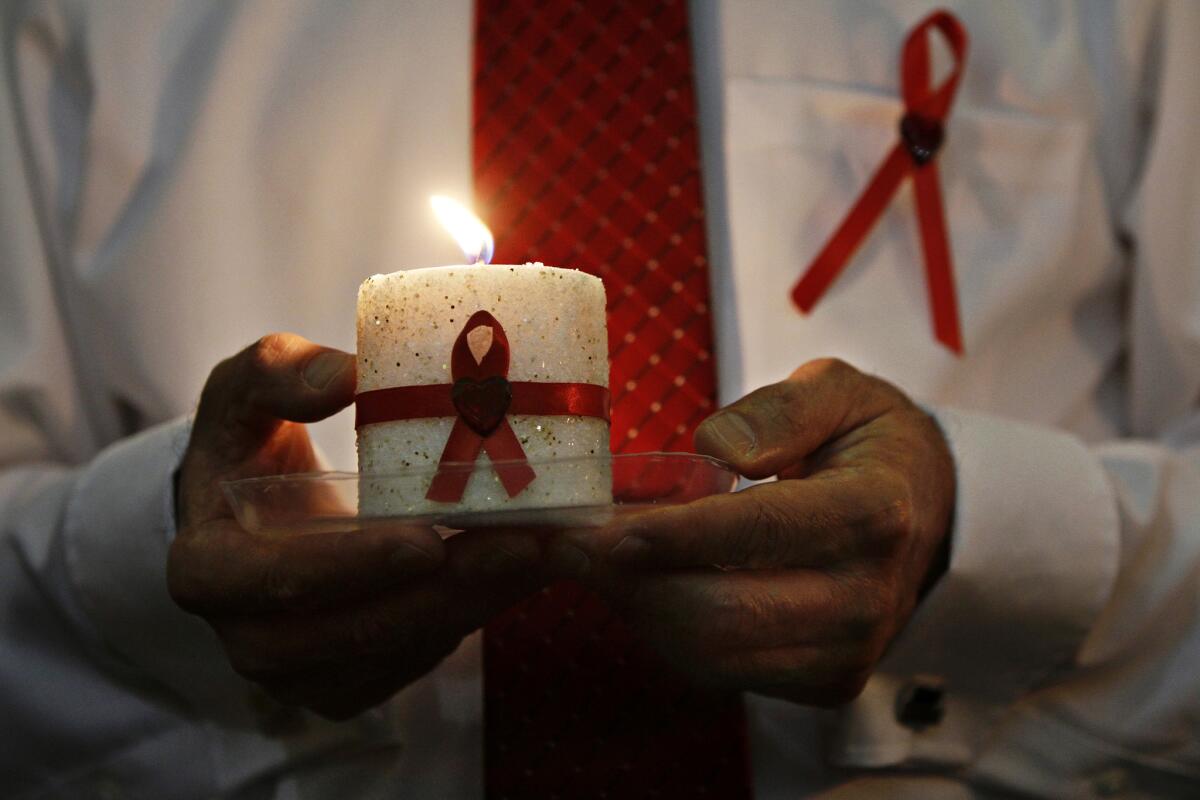L.A. nonprofits battling HIV/AIDS face funding cutoff

- Share via
Los Angeles groups that provide testing, education and other services to prevent HIV/AIDS are facing at least three months without a crucial stream of city support -– an estimated gap of roughly $250,000, according to a city office that allocates money for the programs.
If the money dries up for three months, “that means over 324 gallons of used syringes that we’re going to have to figure out what to do with,” said Shoshanna Scholar, executive director of the LA Community Health Project, formerly known as Clean Needles Now, which runs safe syringe disposal programs.
To reach out to people in need of HIV/AIDS services, “we hang out under bridges. We meet people in the projects. We spend time in homeless encampments,” Scholar said. Without the money, “these are things that just don’t happen.”
The support could be halted because of changes in how the city can use federal money from the Department of Housing and Urban Development, City AIDS Coordinator Ricky Rosales said. In the past, all of the money his city office gives out for HIV/AIDS prevention came from a federal block grant.
However, changes in how city programs are counted under federal spending rules left “more projects competing for a smaller pot of money,” Rosales wrote in a letter last week to local groups.
A HUD spokeswoman was unable to comment Monday on what had changed. Jeff Millman, a spokesman for Mayor Eric Garcetti, said a new interpretation of federal regulations ended up sharply limiting the federal funding available for many existing programs.
Rosales said that to replace the dollars that HIV/AIDS prevention had been getting under the federal grant, the AIDS coordinator’s office is going to seek money from the city general fund –- the bread-and-butter budget for basic city services.
But that city money wouldn’t start flowing until July. The federal grants that the HIV/AIDS programs had relied on expire at the end of March, so the groups now face “a period of at least three months where we will not be able to fund any contracts,” Rosales wrote in his letter.
Local groups would ordinarily receive roughly $250,000 during that period, he told The Times. “The funding will run out in 15 days, essentially,” Rosales said.
Based on yearly figures from the office, Scholar estimated that a three-month dry spell would result in 7,500 fewer HIV tests conducted, 2,200 people who regularly use needle exchange programs having to leave the city to get help, and more than 290,000 used syringes with “nowhere to go.”
In addition, she estimated that 38 jobs could be at risk. At the nonprofit Bienestar, the temporary freeze in funding could force two people to be laid off, said its director of counseling and testing, Joe Montes. The organization would normally receive roughly $27,000 over those three months for its programs.
Even after those three months, funding for groups like his could be pinched. City officials have been trying to scrounge up money to cover the federal funding that the AIDS coordinator’s office will no longer get, but have found only 57% of its current budget for the next year so far, Rosales said –- roughly $600,000 instead of more than $1 million.
As the city works to craft its budget for next year, “we are using other funds, city funds, to try to restore as much funding to this program and others as possible,” Millman said. But he added that the city would probably only be able to restore “some but not all of the funding.”
“These federal funds were absolutely critical for providing valuable services to L.A. residents,” Millman said.
Scholar and others from local nonprofits are urging the city to find a way to cover the three-month gap in funding. They also want to prevent HIV/AIDS funding from dropping in the coming year, arguing that it will ultimately cost the city more if infections rise.
Millman said the City Council is expected to take up the issue of the three-month gap by the end of the month. The council is already reviewing how much the programs will be allocated next year.
Twitter: @latimesemily
More to Read
Sign up for Essential California
The most important California stories and recommendations in your inbox every morning.
You may occasionally receive promotional content from the Los Angeles Times.











